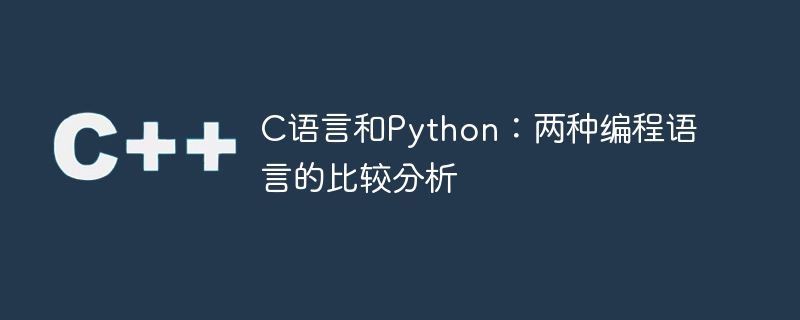

C language and Python: Comparative analysis of two programming languages
In today's programming world, C language and Python are both very popular programming languages. Each of them has its own unique characteristics and advantages and can meet different types of programming needs. This article will conduct a comparative analysis of C language and Python, discuss it in detail from the aspects of syntax, performance, application fields, etc., and give some code examples to help readers better understand the differences between the two languages.
Grammar comparison:
First, let’s take a look at the similarities and differences between the syntax of C language and Python. C language is a structured, procedural programming language with relatively strict syntax and requires strict syntax rules and semantics. For example, when defining a variable, you need to specify the data type, and the control structure needs to be wrapped in braces, etc. Python is an interpretive, object-oriented programming language with a relatively concise and clear syntax. It does not need to explicitly declare the data type of variables, and uses indentation to represent code blocks.
The following is a simple code example, a program that outputs "Hello World" written in C language and Python:
C language code:
#include <stdio.h>
int main() {
printf("Hello World
");
return 0;
}Python code:
print("Hello World")As can be seen from the above code, Python's syntax is more concise and easy to read, while C language pays more attention to details and specifications.
Performance comparison:
In terms of performance, C language is generally considered more efficient than Python. This is because C language is a compiled language, and the code is compiled into machine code before running, making it faster to execute. Python is an interpreted language, and the code is interpreted and executed line by line when running, so it is relatively slow.
The following is a simple program to calculate the Fibonacci sequence, written in C language and Python respectively:
C language code:
#include <stdio.h>
int fibonacci(int n) {
if (n <= 1) {
return n;
} else {
return fibonacci(n-1) + fibonacci(n-2);
}
}
int main() {
int n = 10;
printf("Fibonacci sequence up to %d: ", n);
for (int i = 0; i < n; i++) {
printf("%d ", fibonacci(i));
}
return 0;
}Python code:
def fibonacci(n):
if n <= 1:
return n
else:
return fibonacci(n-1) + fibonacci(n-2)
n = 10
print("Fibonacci sequence up to", n, ": ", end='')
for i in range(n):
print(fibonacci(i), end=' ')As can be seen from the above code, programs written in C language are faster when calculating the Fibonacci sequence.
Comparison of application fields:
C language and Python have their own advantages in application fields. C language is widely used in system programming, embedded development, game development and other fields because it can directly operate memory and has fast execution speed. Python is more popular in fields such as data analysis, artificial intelligence, and web development because of its rich libraries and concise syntax.
Conclusion:
In general, C language and Python each have their own characteristics and advantages. Which language to use depends on the specific needs and project conditions. Understanding the differences in syntax, performance, and application areas between the two languages can help us better choose the appropriate programming language to complete project tasks. Hope this article can be helpful to readers.
The above is the detailed content of C language and Python: a comparative analysis of two programming languages. For more information, please follow other related articles on the PHP Chinese website!




